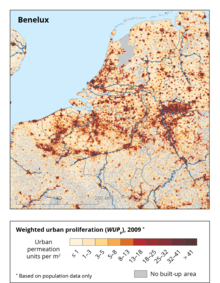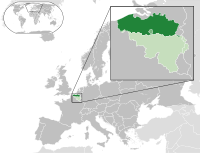Flemish Diamond



The Flemish Diamond (Dutch: Vlaamse Ruit) is the Flemish reference to a network of four metropolitan areas in Belgium, three of which are in the central provinces of Flanders, together with the Brussels-Capital Region.[1] It consists of four agglomerations which form the four corners of an abstract diamond shape: Brussels, Ghent, Antwerp and Leuven.[2]
In 2007, approximately 5 million people lived in this area, with a population density of about 820 per square kilometer[3] which accounted for roughly 47% of the total population of the country (c. 10.5 million).
History
The Flemish Diamond is a regional government concept not officially recognized by the Belgian central authority, the Federal government, which recognizes no poly-centric conurbation in Belgium that crosses regional borders and includes Brussels as part of it. The other major Belgian metropolitan areas that are in relative proximity to the national capital (that lie within a radius of approximately 50 kilometres (31 mi) around Brussels) are the exclusive competence of the regional authorities. These autonomous authorities may choose to include or exclude Brussels in their own volition. And as such, the autonomous Flemish government developed the geographic and socio-economic concept of Vlaamse Ruit or "Flemish Diamond" in the 1990s. The Francophone counterpart is the Triangle Wallonie ("Walloon Triangle"), consisting of Brussels and three Walloon metropolitan areas, namely Mons, Charleroi, and Namur.[4][5]
Dynamics
The distance from Antwerp to Brussels is approximately 51 km (32 mi). The city of Mechelen is in the middle, and towards Brussels the industrial area of Vilvoorde. With the Port of Antwerp stretching to the north, this has long been recognized as a major north–south urban and industrial axis. The western triangular area of the larger cities of Antwerp-Brussels-Ghent comprises the cities of Lokeren located west of Sint-Niklaas, Dendermonde north of Aalst as well as the industrial area Boom – Willebroek, and is generally slightly less urbanized. Such may also be true for the smaller eastern Antwerp – Brussels – Leuven triangle, comprising the city of Lier.
The name refers to the geometrical shape of a diamond, corresponding to the location of the four cities and surrounding metro areas, which are among the most urbanized and industrialized – and prosperous[6] — in Belgium. It has strong economical ties with the metropolitan regions of the Randstad in the Netherlands, and Rhine-Ruhr in Germany.[7] It also links its peripheral area for more than a hundred kilometers, exceeding Flanders, to the international and global economy.[7]
The economic activities in the relatively larger metropolitan areas are distinct, with an emphasis on industry in Antwerp, mainly because of its major port, versus on administration for Brussels, as Belgian capital and its function for the European Union and NATO. Though the centrally located city in both the Diamond and its major north–south industrial axis has two industrial zones within the municipal boundaries, Mechelen is also seen as a commuter town for its many commuters to those cities.
Apart from Hasselt University in Limburg, all the Flemish universities are located at the provincial or national capitals at each corner of the Diamond, while Mechelen plays an important role because of its other types of higher education. Though a distant affiliate of the Catholic university of Leuven offers the first few years of some bachelors in Kortrijk,[8] for higher degrees the University of Ghent is the nearest for the province of West Flanders,[9] as it lies outside the Flemish Diamond.
See also
- Sillon industriel, Wallonia's urban belt
- Metropolitan areas in Belgium
- Blue Banana
References
General sources
- Vanhaverbeke, Wim (January 1997). "Het belang van de Vlaamse Ruit vanuit economisch perspectief" [The importance of the Flemish Diamond from an economical perspective] (in Dutch). Netherlands Institute of Business Organization and Strategy Research, University of Maastricht, the Netherlands. Archived from the original on 14 March 2007. Retrieved 19 May 2007.
- Houvenaghel, Sofie; Vanhaverbeke, Wim (June 1997). "Economische aspecten en relaties van omliggende gebieden met het stedelijk netwerk van de Vlaamse Ruit" [Economical aspects and relations of surrounding areas with the urban network of the Flemish Diamond] (in Dutch). Netherlands Institute of Business Organization and Strategy Research, University of Maastricht, the Netherlands. Archived from the original on 24 July 2011. Retrieved 14 March 2007.
- de Vries, Jochem (2002). Grenzen verkend, Internationalisering van de ruimtelijke planning in de Benelux. Stedelijke en Regionale Verkenningen (in Dutch). Delft: DUP Science, Delft University Press. p. 383. ISBN 978-90-407-2263-9. Retrieved 4 March 2011. (Dissertation, Faculty of Social and Behavioural Sciences, University of Amsterdam)
Inline references
- ^ Note: The Flemish government has no authority on economical matters in the Brussels Capital Region, which with nearby Flemish municipalities (with industrial areas in the directions of the Brussels airport, which is located in Flanders, and of or at the small cities of Vilvoorde and Asse) (de Vries, 2002, p. 139), forms one of the major economic metropolitan areas of the 'Flemish' Diamond'.
- About constitutionally defined competences, see Communities, regions and language areas of Belgium.
Association of a fraction of the Walloon Region with the Brussels metropolitan area, by some sources, was contested by others. See e.g.:
- Vandenbussche, Barbara. "Waals-Vlaamse transfers in kaart gebracht ('Wallonian-Flemish transferts mapped')" (in Dutch). DeWereldMorgen.be (news site), Brussels region, Belgium. Archived from the original on 2 February 2014. Retrieved 4 March 2011.
- Cantillon, Bea; De Blust, Seppe; Van den Heede, Aaron (July 2010). "2.1. Vlaams en Randstedelijk, de draagkracht van de sociale zekerheid". De geografie van de sociale zekerheid in België (in Dutch). University of Antwerp. p. 2. Retrieved 4 March 2011.
De Vlaamse ruit wordt in dit bericht gedefinieerd vanuit een economisch-geografische realiteit. De Vlaamse ruit wordt gevormd door het gebied tussen de steden Brussel, Antwerpen, Gent en Leuven en hun forensen. Waals Brabant hoort zo grotendeels bij de Vlaamse ruit. ('The Flemish Diamond is in this message defined from an economical-geographical reality. The Flemish Diamond is formed by the area between the cities of Brussels, Antwerp, Ghent, Leuven and their commuter suburbs. As such, Walloon Brabant for a large part belongs to the Flemish Diamond.')
- Mouton, Alain, ed. (20 August 2010). "Kritiek op CSB-studie over Vlaams-Waalse transfers". Trends Weekly (in Dutch). Archived from the original on 27 October 2010. Retrieved 4 March 2011.
Herman Deweerdt (AK-VSZ Archived 27 November 2020 at the Wayback Machine): Het is zeker waar dat de Vlaamse ruit een centrum van economische activiteit is en dus een zeer belangrijke basis vormt voor de financiering van de sociale zekerheid, [m]aar voor de gelegenheid Brussel weglaten en er Waals-Brabant bijvoegen om dan te beweren dat het centrum van het land de rest financiert, is niet correct. ('Surely the Flemish Diamond is a centre of economic activity and thus forms a base for social security financing, but for that occasion omitting Brussels and adding Walloon Brabant, for then posing that the country's centre is financing the remainder, is not correct.')
- ^
Wintjes, René; Cobbenhagen, Jan (December 1999). "Flanders Language Valley; Industrial Districts and Localized Technological Change" (PDF). MERIT, University of Maastricht, the Netherlands: 5. Retrieved 2 March 2011.
the economic and scientific core of Flanders: 'Vlaamse Ruit' (Gent, Antwerpen, Brussel, Leuven)
{{cite journal}}: Cite journal requires|journal=(help) - ^ Meijers, Evert J. (2007). Synergy in Polycentric Urban Regions: Complementarity, Organising Capacity and Critical Mass. IOS Press. p. 54. ISBN 9781586037246.
- ^ Cattan, Nadine (2007). Cities and Networks in Europe: A Critical Approach of Polycentrism. ISBN 9782742009251.
- ^ "Uitgelicht: Kosmopolis naar wens". Brusselnieuws (Brussel Deze Week). Archived from the original on 9 November 2013. Retrieved 9 November 2013.
- ^
Cantillon, Bea; De Blust, Seppe; Van den Heede, Aaron (July 2010). "2.1. Vlaams en Randstedelijk, de draagkracht van de sociale zekerheid". De geografie van de sociale zekerheid in België (Report) (in Dutch). University of Antwerp. p. 2. Retrieved 4 March 2011.
Een inwoner van het Vlaams Gewest verdient met een gemiddeld inkomen [...](een welvaartsindex van 106) beduidend meer dan een inwoner van het Waals Gewest ([...] 93,45) of het Brussels Hoofdstedelijk Gewest ([...] 85,53). [...] Voor de steden Gent, Antwerpen, Brussel en Leuven strekt dit hoger gemiddeld inkomen van de randgemeentes zich uit over heel de Vlaamse ruit. ('An inhabitant of the Flemish Region earns with an average income [...] (a prosperity index of 106) significantly more than an inhabitant of the Walloon Region ([...] 93,45) or the Brussels Capital Region ([...] 85,53). [...] For the cities of Ghent, Antwerp, Brussels and Leuven this higher average income of the suburbs spreads over the entire Flemish Diamond.') [Base: Belgium is 100]
- ^ a b Vanhaverbeke, Wim (1998). "An economic analysis of the Flemish Diamond". European Planning Studies. 6 (4): 425–442. doi:10.1080/09654319808720472.
Empirical evidence shows that the economic relations of the Diamond with its immediate environment (100–150 km) are very important for the latter and that the Diamond plays the role of a gateway to the European and global economy for regions in the immediate environment. Finally, there is strong empirical evidence that there exist intensive economic transactions between the Flemish Diamond, the Randstad and the Rhine-Ruhr Metropolitan Region that go way beyond their share in the GDP.
- ^ Note:The campus at Kortrijk, offers the first two years in a number of disciplines, for some of which also a third year was announced in 2011. For higher levels or for other disciplines, one must go to a university outside the province – the parent at Leuven being one of the most remote in Flanders. See:
- "Welcome to Campus Kortrijk of K.U.Leuven!" (PDF). Katholieke Universiteit Leuven Campus Kortrijk (KULAK). Archived from the original (PDF) on 3 October 2011. Retrieved 3 March 2011.
- "Volledige bachelors aan Kulak ('Complete bachelors at Kulak')" (in Dutch). Katholieke Universiteit Leuven Campus Kortrijk (KULAK). Archived from the original on 3 October 2011. Retrieved 3 March 2011.
[V]anaf [...] academiejaar (2011–2012) kan je voor bepaalde studierichtingen een jaar langer studeren in Kortrijk en er ook het bachelordiploma behalen. ('From academical year 2011–2012, for particular disciplines you can study a year longer at Kortrijk, and also obtain a bachelors degree there.')
- "Welcome to Campus Kortrijk of K.U.Leuven!" (PDF). Katholieke Universiteit Leuven Campus Kortrijk (KULAK). Archived from the original (PDF) on 3 October 2011. Retrieved 3 March 2011.
- ^ Note: Universities relatively near the westernmost part of the West Flemish province, can also be found at Lille, France, but offer no courses in the standard language of Flanders.
